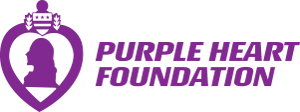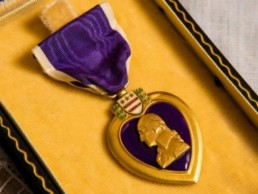John F. Kennedy: Purple Heart Recipient, Father, President
John Fitzgerald Kennedy (JFK), born May 29, 1917 in Boston, Massachusetts, was the only U.S. President in history (to-date) to receive the Purple Heart medal. Kennedy was born into a wealthy political family, travelled the world after high school, and followed in his father’s footsteps by becoming a ‘Harvard Man’. In spite of JFK’S graduating cum laude with a Bachelor of Arts in government and a concentration in International Affairs at Harvard, his older brother Joseph P. Kennedy, also a ‘Harvard Man’, was tapped by their father to seek the presidency. In 1941, before beginning a political journey, both Kennedy brothers enlisted in the United States military to demonstrate their pride and service to this country.
On one fateful night of August 1, 1943, Naval Lieutenant John F. Kennedy was commanded to torpedo Japanese destroyers carrying supplies to soldiers fighting allied forces. “It was as dark as if you were in a closet with the door shut,” recalled one of JFK’s crewmen, Barney Ross1. So with only 1 active engine, little visibility, in the dead of night, phosphorescent plankton exposing every movement in the water, no radar and Japanese fighter pilots flying overhead… the brave Lieutenant Kennedy and his 13-man crew attempted to carefully make their way through the waters of the Solomon Islands on Patrol Torpedo (PT) boats. Within moments, Japanese fighter pilots dropped 2 bombs nearby, giving away their position, and a 388ft Japanese destroyer rammed their helpless wooden PT-109’s. Many of his men were injured, an engineer named McMahon was badly burned and 2 died in the attack. After swimming hundreds of miles to collect his men on what remained of his PT-109 and spending the night in enemy waters with no sign of rescue, JFK began to assert his leadership and take command. He gathered his men for a democratic vote on what to do next, whether to fight or surrender if approached by the Japanese. It is said that the crew all responded, “It’s up to you, boss”. And so, he commanded his crew to swim to the nearest island. Suffering from his own back injury, Kennedy heroically took a piece of McMahon’s life jacket in his mouth and pulled his crewmember suffering from agonizing burns for 3 miles until they reached shore. The crew spent 24hrs on an island with no fresh water, inedible coconuts, and no other food sources before Kennedy suggested they swim to another nearby island. It was there, on August 5th, JFK ran into two native men whom he handed a smooth-shelled coconut that he had carved into it “NAURO ISL COMMANDER….NATIVE KNOWS POS’IT…HE CAN PILOT…11 ALIVE NEED SMALL BOAT…KENNEDY.” Somehow, that coconut shell made its way to a New Zealand infantry patrol who came to Kennedy’s aid and helped him get in contact with his base, saving his crew.
His bravery and injury sustained during that mission would earn him a Navy & Marine Corps Medal and the Purple Heart. That experience left an undeniable mark on the man who would become the nation’s 35th president. Throughout the rest of his service, John F. Kennedy held onto that soft-shelled coconut that saved his life and later turned it into a paperweight for his desk in the Oval Office.
Almost exactly one year later, his older brother Joe met his untimely demise during a volunteer mission where he was posthumously awarded the Purple Heart2. Joseph P. Kennedy’s death in 1944 would change John F. Kennedy’s course in history, as the task of seeking the presidency now fell to him, the eldest of his seven (7) remaining siblings.
JFK’s father used his political influence and boasted his son’s Purple Heart, war-hero reputation to support John’s rise to presidency but it was his humility, charisma and progressive ideology that helped him win. His campaign was a family affair, with his father’s funding, his family’s influence, and his brother as his campaign manager. His inauguration was just as family oriented, with his wife and two small children by his side the whole time. John F. Kennedy was sworn in as the 35th president on January 20, 1961, only 17 days after his son, John F. Kennedy Jr was born. “Busy as he was with his other responsibilities, he always took time to delight in his children…the nation shared in the warmth of their family affection 3”. JFK fought for equality, civil rights, health care reform and more, while maintaining a strong relationship with his family and their faith. The Kennedy era White House was described by First Lady Jaqueline Kennedy herself, as “Camelot”, the perfect fairytale land.
However, the fairytale ended on November 22, 1963 when President John F. Kennedy was assassinated during a motorcade ride from Dallas’ Love Field to give a speech at a local Trade Mart. Along the way, three shots were fired at the motorcade, two striking JFK, and only 30 minutes later at a nearby hospital the president was pronounced dead. Jaqueline Kennedy took an active role in planning her husband’s state funeral which took place at the Cathedral of St. Matthew the Apostle in Washington, DC. As John F. Kennedy’s flag draped casket was carried down the steps of the cathedral, three-year-old John F. Kennedy, Jr. rendered the final salute to his father.
Jacqueline Kennedy led the procession to his final resting place at nearby Arlington National Cemetery on foot and lit the eternal flame.
The last remaining member of John F. Kennedy’s immediate family is his daughter, Caroline, who remembers her father fondly. In a CNN interview she states “I’ve thought about him and missed him every day of my life, but growing up with out him was made easier thanks to all the people who kept him in their hearts, who told me that he inspired them to work and fight and believe in a better world.”4
We recognize the late president John F. Kennedy as not only a Purple Heart recipient, but as a husband, a son, a father and a good man that all others should aspire to emulate.
Happy Father’s Day.
Mesothelioma Awareness Day: How This Disease Continues to Impact Veterans
Every 26th of September, Mesothelioma Awareness Day (MAD) is recognized as a day to spread information about this rare disease and educate people about the dangers of its only known cause, asbestos exposure. Of the nearly 3,000 Americans diagnosed with mesothelioma each year, 30 percent of this total are veterans. It is important that we acknowledge the veteran population affected by this disease and continue efforts towards finding a cure.
What is Mesothelioma?
Mesothelioma is a form of cancer that primarily affects the lining of the lungs, but can also be present in the lining of the abdomen and heart. Due to its prolonged latency period, symptoms of this disease typically do not arise for nearly 10 to 50 years. When symptoms do begin to appear, oftentimes, the disease has already progressed to an advanced stage, making treatment options extremely limited.
Historically, the cause of mesothelioma cancer has been linked to asbestos exposure. Asbestos is a naturally occurring mineral that was often used in materials prone to heat and friction. When asbestos is disturbed, airborne fibers have the ability to be inhaled or ingested, gaining access to our internal organs. These fibers lay dormant within our bodies where they cause inflammation and scarring, leading to the development of tumors.
For those diagnosed with mesothelioma, the prognosis is most often very poor. Patients who are diagnosed at an earlier stage are given between 16 to 21 months to live post-diagnosis, which is a limited amount of time to pursue treatment.
How Are Veterans Affected?
Service men and women of our military are susceptible to asbestos exposure as a result of mass historic use of asbestos-products. While there has been a decline in asbestos usage and stricter regulations, asbestos may still be present on military bases, naval ships, and aircraft equipment. Because of this, there is a steady diagnosis rate amongst veterans. This will remain unchanged until asbestos is completely banned in the United States or the government issues a mandate for all asbestos to be removed from military locations.
Those who have served our country between 1920 to 1980 are at the highest risk of developing an asbestos-related disease, as this was the height of asbestos usage. Locations such as the sleeping barracks of ships used in the Navy were tight and limited, allowing for a high concentration of fibers to be present if asbestos was disturbed. Other branches that are affected by asbestos include the Air Force, Army, Coast Guard and Marines through asbestos materials used in things such as aircraft braking systems, military vehicles, and fireproofing for ships.
An additional risk factor that should be kept in mind is the use of asbestos in other countries. Members of our military can also be exposed while on deployment and stationed in areas that are war-torn, and as a result, have created large amounts of debris and rubble.
Across borders, many older buildings and homes on United States bases could be harboring asbestos-containing materials, such as roofing and flooring tiles. While it is difficult to avoid exposure because asbestos fibers are invisible to the naked eye, with the right protective equipment and knowledge, we can work to keep our military safe from these asbestos-related diseases.
Symptoms & Detection
Veterans that believe they may have been exposed to asbestos should receive checkups frequently and monitor their health closely. Symptoms of mesothelioma often mimic those of other less serious illnesses and should be evaluated no matter how seemingly minor. Some of the symptoms are as follows:
- Abdominal swelling
- Breathing difficulties
- Muscle Weakness
- Chest pain
- Coughing
Testing such as X-rays and CT scans can provide insight into underlying symptoms and help identify any abnormalities. Blood tests should also be performed regularly to see if there is an overabundance of mesothelin present in the blood, which may hint at malignancy. It is vital to monitor symptoms immediately. This will allow for the best chance of survival and successful treatment if the disease is caught early.
What to do if You’re Diagnosed
If you are diagnosed with mesothelioma, the next step is to understand your treatment options. It is important to research and connect with an oncologist that specializes in mesothelioma cancer, as they will be able to provide you with the latest and most effective treatments specific to your diagnosis. Cancer treatment costs can oftentimes be burdensome to families, and when diagnosed with mesothelioma, there is typically a party that is liable for the disease that you have developed. To manage these costs better, it is your right to seek legal action, as there are victim compensation funds set in place to ensure those who are affected by asbestos exposure receive the funding they deserve for their treatment.
How You Can Help
Mesothelioma is one of the lesser-known forms of cancer, receiving minimal coverage in mainstream oncology. With the support of others and by spreading awareness, this cancer will not only be diagnosed less, but a cure could be on the horizon. Through donating to the Purple Heart Foundation, the MOPH National Service Officer program will continue to help veterans fight for their VA benefits and receive much-needed care for injuries and illnesses, such as mesothelioma, that stem from service to our country.


